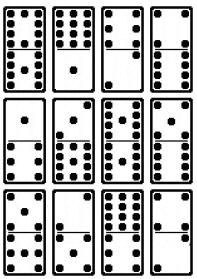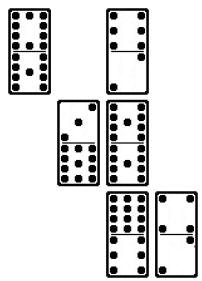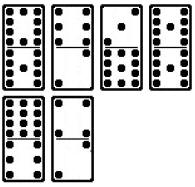Good Neighbors Domino Solitaire
Jeux
Dominos
A solitaire game for one player, played with a
Double-Twelve set of dominoes, or in other versions, a Double-Nine or Double-Six
set.
Play:
The player shuffles the dominoes, facedown, then
draws 12 tiles and places them in three horizontal rows of four tiles.
The player then turns them face-up, completing the
initial layout. The remaining tiles form the boneyard and are drawn during the
course of play.
The player may now in turn remove any pair of tiles
that are "good neighbors". "Good neighbor" tiles are any two tiles next to each
other (including diagonally) that have the same suit marked on either end.
As many "good neighbor" pairs of tiles as the player
wishes may be removed, but the player must remove at least one in each turn.
After each turn, the player must move the remaining tiles
in the layout up and towards the top left-hand corner of the layout, filling the
empty spaces left by the removed pairs of "good neighbors".
This can be done in three stages. Firstly, moving any
tiles with a space immediately to their left, over to the left and filling the
empty space(s) next to them.
Secondly, moving any tiles from the left-hand side of
the middle row up to any empty spaces on the right-hand side of the top row.
And thirdly, moving any tiles from the left hand side of
bottom row up to the right-hand side of the row(s) above it.
Once this rearranging of the tiles is done, the player
draws tiles from the boneyard and places them, in order, left to right, and top
to bottom in the empty spaces of the layout, so it is once more three rows of
four tiles.
Play continues as before until no more pairs of "good
neighbors" may be removed, and the game is lost, or until all the tiles are
played and removed from the layout, and the game is won.
Example

The 1-12 & 1-6
(diagonally)
and 4-8 & 5-8
and 5-7 & 2-5
are "good
neighbors"
so may be removed. |

Good neighbors have been
removed
leaving empty spaces. |

The tiles are moved to the left
filling the empty spaces to their left in the layout. |

The tiles are moved up filling
the empty spaces above and to
the left. |
Variations:
When played with a Double-Nine set, the layout is
made of three rows of three tiles, and the game is won when all but one tile is
left at the end of the game.
When played with a Double-Six set, the layout is made of
two horizontal rows of six tiles, and no tiles must be left..
Recherche personnalisée





